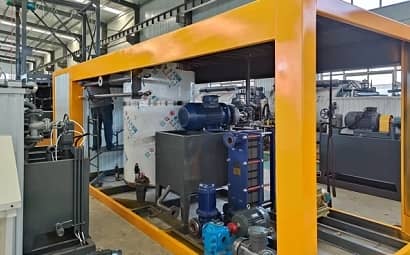What are the advantages of emulsified bitumen equipment automation:
1. It is versatile. Our company's modified bitumen equipment reminds that the same emulsion can be used for large-scale sealing and can also be used for small-scale pit repair work.
2. It is energy-saving. The kerosene or gasoline content in diluted bitumen can reach 50%, while the modified emulsified bitumen equipment only contains 0-2%. This is a valuable saving behavior in the production and utilization of white fuel, which only relies on the increase of light oil solvent to reduce the viscosity standard of bitumen.
3. Easy to use. The modified bitumen equipment proposes that small-area emulsion applications can be directly poured and spread by hand, such as small-area pit repair work, crack filling materials, etc., and small quantities of cold mixes only need basic equipment.

Emulsified bitumen breaks asphalt into tiny particles through mechanical force under the action of emulsifiers, and evenly disperses them in water to form a stable emulsion. Emulsified bitumen equipment is a mechanical device used to heat melt the emulsion, disperse it in an aqueous solution containing an emulsifier in the form of tiny droplets through mechanical shearing, and form an oil-in-water asphalt emulsion. The emulsified asphalt equipment produced by Sinoroader has the following features: Real-time measurement and monitoring of flow, ratio, temperature and weight. The keyboard sets the oil-water ratio, hourly output, total output at one start-up, control parameters, alarm parameters and sensor correction values, etc. The set values ??can be retained for a long time. The oil-water setting ratio is wide and can be adjusted at any time within the range of 10%-70%. The temperature, liquid level and ratio are precisely controlled, the product quality is stable, the material is transmitted in a closed manner, the degree of automation is high, and standardized management is convenient.
 Albanian
Albanian  Russian
Russian  Arabic
Arabic  Amharic
Amharic  Azerbaijani
Azerbaijani  Irish
Irish  Estonian
Estonian  Odia (Oriya)
Odia (Oriya)  Basque
Basque  Belarusian
Belarusian  Bulgarian
Bulgarian  Icelandic
Icelandic  Polish
Polish  Bosnian
Bosnian  Persian
Persian  Afrikaans
Afrikaans  Tatar
Tatar  Danish
Danish  German
German  French
French  Filipino
Filipino  Finnish
Finnish  Frisian
Frisian  Khmer
Khmer  Georgian
Georgian  Gujarati
Gujarati  Kazakh
Kazakh  Haitian Creole
Haitian Creole  Korean
Korean  Hausa
Hausa  Dutch
Dutch  Kyrgyz
Kyrgyz  Galician
Galician  Catalan
Catalan  Czech
Czech  Kannada
Kannada  Corsican
Corsican  Croatian
Croatian  Kurdish (Kurmanji)
Kurdish (Kurmanji)  Latin
Latin  Latvian
Latvian  Lao
Lao  Lithuanian
Lithuanian  Luxembourgish
Luxembourgish  Kinyarwanda
Kinyarwanda  Romanian
Romanian  Malagasy
Malagasy  Maltese
Maltese  Marathi
Marathi  Malayalam
Malayalam  Malay
Malay  Macedonian
Macedonian  Maori
Maori  Mongolian
Mongolian  Bengali
Bengali  Myanmar (Burmese)
Myanmar (Burmese)  Hmong
Hmong  Xhosa
Xhosa  Zulu
Zulu  Nepali
Nepali  Norwegian
Norwegian  Punjabi
Punjabi  Portuguese
Portuguese  Pashto
Pashto  Chichewa
Chichewa  Japanese
Japanese  Swedish
Swedish  Samoan
Samoan  Serbian
Serbian  Sesotho
Sesotho  Sinhala
Sinhala  Esperanto
Esperanto  Slovak
Slovak  Slovenian
Slovenian  Swahili
Swahili  Scots Gaelic
Scots Gaelic  Cebuano
Cebuano  Somali
Somali  Tajik
Tajik  Telugu
Telugu  Tamil
Tamil  Thai
Thai  Turkish
Turkish  Turkmen
Turkmen  Welsh
Welsh  Uyghur
Uyghur  Urdu
Urdu  Ukrainian
Ukrainian  Uzbek
Uzbek  Spanish
Spanish  Hebrew
Hebrew  Greek
Greek  Hawaiian
Hawaiian  Sindhi
Sindhi  Hungarian
Hungarian  Shona
Shona  Armenian
Armenian  Igbo
Igbo  Italian
Italian  Yiddish
Yiddish  Hindi
Hindi  Sundanese
Sundanese  Indonesian
Indonesian  Javanese
Javanese  Yoruba
Yoruba  Vietnamese
Vietnamese  Hebrew
Hebrew  Chinese (Simplified)
Chinese (Simplified)






